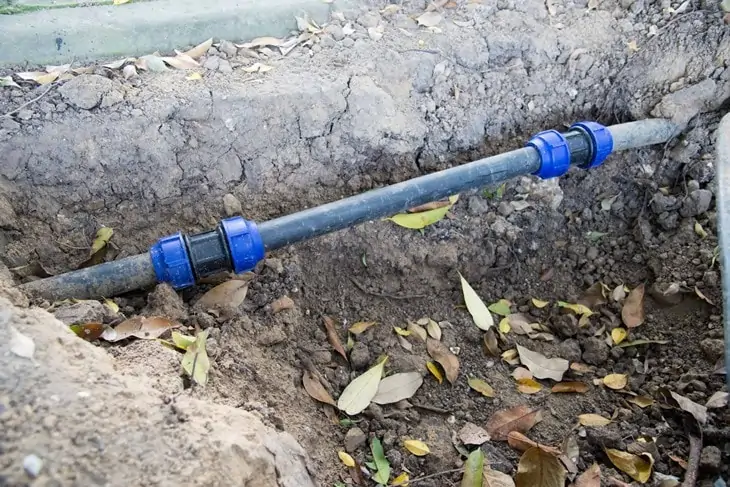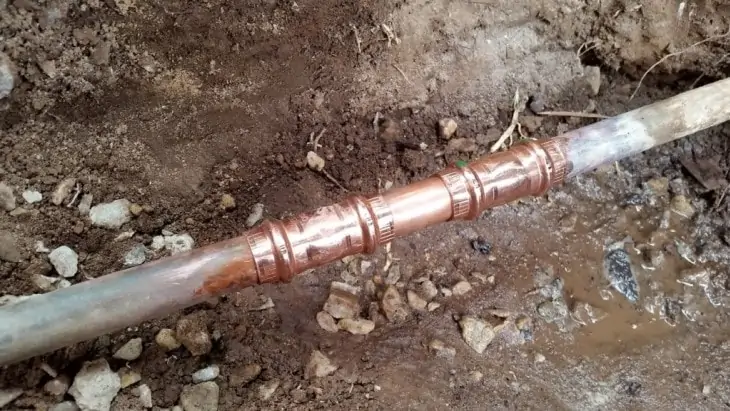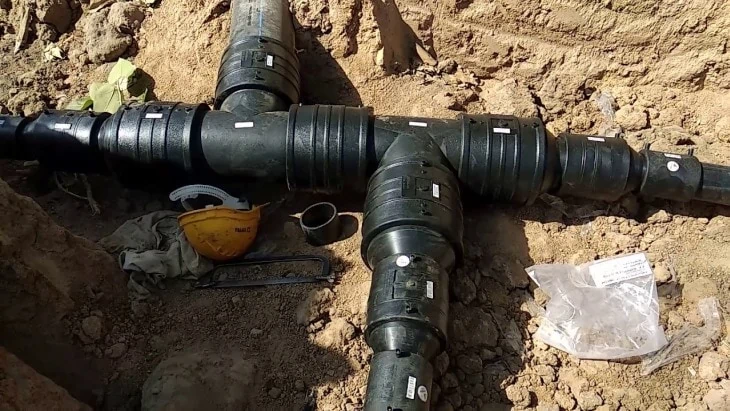Making sure all of your plumbing needs are met is essential for all new home builds or remodels. It’s important you understand the options available for laying your underground pipe and also understand the pros and cons of each one.
The most common options for underground water supply pipes are PEX, PVC, Copper, and HDPE. HDPE and PEX are the best choices due to their durability and higher PSI rating.
Table of Contents
Things to Consider for Underground Water Pipes

Because the pipes in question will be underground and provide water directly to your structure, there are several considerations to keep in mind when trying to decide what pipe will work best.
PSI Rating of the Pipe
PSI stands for “Pound per Square Inch”. When a pipe is rated for a certain PSI, that means the pound per square inch pressure of the water should not exceed that number.
If the water going through the pipe exceeds the pressure rating, you risk your pipe bursting. The pressure can usually be adjusted with a pressure pump or valve, but you want to be sure to choose a pipe that can withstand higher water pressure so your faucets don’t slowly trickle out.
Water Composition
It’s well known that, over time, water can cause corrosion due to the minerals that it carries. You want whatever pipes you lay to be able to withstand it, especially if the water is coming from a well or natural spring.
City water is usually treated to prevent corrosivity.
Soil Composition
Just like water, soil can contain sulfates which alter its pH and make it more corrosive. This is especially true in agricultural soil as the pH needs to be raised or lowered to encourage plant production.
Though there’s nothing wrong with a slightly more corrosive soil, it does mean you are going to want to opt for a pipe that is more resistant to it.
Options for Underground Water Pipes
When you are speaking with the plumbing experts, ask about these top options.
Copper Pipes

Copper pipes in plumbing have been around for decades. Their reliability makes them a go-to for some home builders.
Pros – Copper is one of the most common piping materials, especially for commercial houses. It’s also safely been utilized for gas piping as well. Copper pipes are less likely to freeze and can handle up to 100 psi.
While using metal for piping is not uncommon, copper has come to be preferred over galvanized steel or iron because it does not contaminate the surrounding soil and weighs less than its counterparts.
Cons – There are two major downsides to using copper piping. The first is the cost. Since the price of metals fluctuates constantly, it will cost you more per foot than other non-metal options.
The second downside is that copper is not resistant to soil that doesn’t have a neutral pH. It’s prone to corrosion in agricultural soils and soils that have large amounts of salt and sulfates.
PEX Pipes
PEX means Polyethylene Cross-Linked. You’ve probably seen this piping as its tubes are colorful and it’s utilized in both indoor and outdoor plumbing applications.
Pros – Compared to copper, PEX piping is extremely affordable and easy to install. Most PEX pipes have a 50 year lifespan as they are highly resistant to corrosion. They can be fitted with metal joints so they do not need to be soldered together making this a top-pick for DIY-ers.
It has the same feel as a garden hose so it can bend slightly around curves. It is also color coded so workers and homeowners know exactly what is inside each specific line.
Cons – Even though PEX pipes can be used outdoors, they must be buried because they are easily damaged by sunlight and excessive heat. They often need to be straightened before use. The sun will cause the pipes to form hairline cracks and can cause damage in as little as one month.
Although it can bend like a hose, it can also kink like a hose. It shouldn’t be bent around sharp corners without fitting it with the metal joints or else water pressure can be compromised.
PEX is also not biodegradable or recyclable, so there is a large carbon footprint left behind after purchasing this material.
PVC Pipes
There are two main types of PVC pipe for underground water lines: Regular PVC (polyvinyl chloride) and CPVC (chlorinated polyvinyl chloride).
Pros of PVC – Regular PVC is cheap and easily accessible. It’s also highly resistant to corrosion and a popular choice for simple water transfer and drainage systems.
Cons of PVC – Did you notice how I specified that PVC is a great choice for water transfer? That’s because it’s not a good choice for water distribution, especially inside of a house. Many municipalities actually ban its use as a plumbing option for distribution.
This is because PVC cannot withstand hot water. It will begin to distort and become misshapen, so it is not rated to deliver any water to inside fixtures. It’s still a great choice for irrigation though!
Pros of CPVC – Unlike regular PVC, CPVC is rated to withstand hot water distribution, so it becomes a better choice for water lines that go directly to fixtures. It is also more resistant to corrosion than metal alternatives.
It is more cost-effective in terms of overall maintenance than metal or regular PVC systems.
Cons of CPVC – Even though CPVC can handle hot water, it has a tendency to swell. If installed in an area with high temperature fluctuations, the constant expansion and contraction of the material can reduce the overall integrity of the pipe.
It is also more brittle than other options so there is a higher chance of stress cracks.
HDPE Pipe

HDPE Stands for High-Density Polyethylene. Sometimes it is abbreviated to just “PE”. It is considered the top choice by many professionals due to its durability and applications for use.
Pros – This particular piping material checks all the boxes. It is very affordable and highly resistant to sunlight and corrosion. The temperature fluctuations it can withstand range from -140F, all the way up to 175F.
HDPE pipes for underground water lines are non-toxic, so they won’t leach any chemicals into the soil. Another large benefit to HDPE is that it can be recycled after use and turned into other products.
Certain thicknesses of HDPE can handle a higher psi than any other type of water pipeline.
Cons – Although HDPE is recyclable, it is not biodegradable so it cannot be composted. It must be sent to certain facilities.
If subjected to extremely high temperatures for prolonged periods of time, HDPE can suffer from stress cracks and need to be replaced.
Perhaps one of the biggest drawbacks to this material is that it is highly flammable. In the event of a fire, the entire pipe will burn quickly or become severely damaged.
Final Thoughts
You should always consult with experts before you purchase your underground water pipes. They may be able to point out certain things that you normally would not have thought of.
However, it never hurts to have knowledge of your options before you do so. Make sure you ask questions regarding your soil and water composition so that together, you and the experts can make the best decision for your house.

